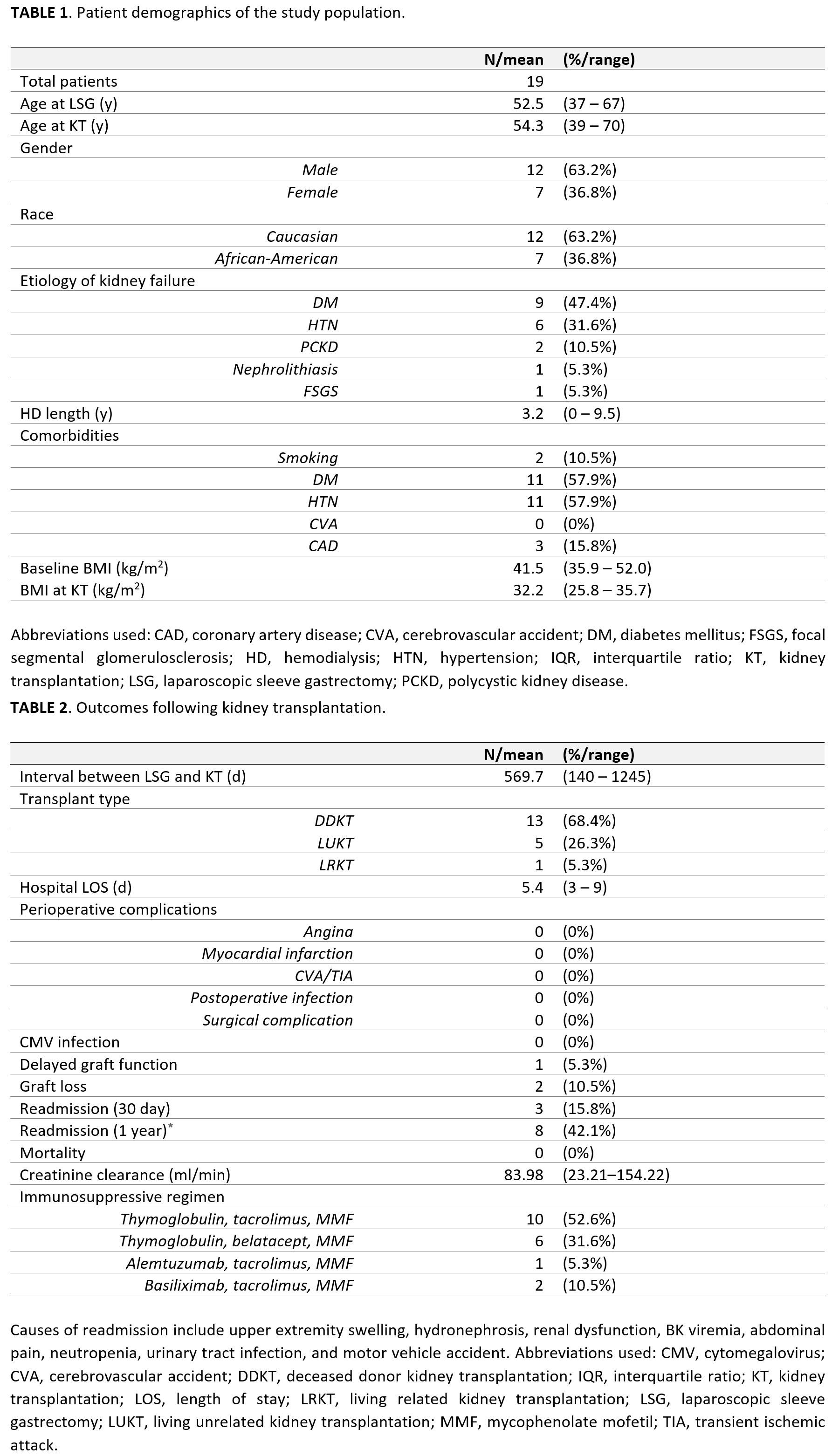Laparoscopic Sleeve Gastrectomy Improves Renal Transplant Candidacy and Posttransplant Outcomes in Morbidly Obese Patients.
Surgery, University of Cincinnati, Cincinnati, OH
Meeting: 2017 American Transplant Congress
Abstract number: 522
Keywords: Graft function, Kidney transplantation, Obesity, Post-operative complications
Session Information
Session Name: Concurrent Session: Kidney General Outcomes
Session Type: Concurrent Session
Date: Tuesday, May 2, 2017
Session Time: 4:30pm-6:00pm
 Presentation Time: 5:42pm-5:54pm
Presentation Time: 5:42pm-5:54pm
Location: E354a
BACKGROUND: Morbid obesity remains a barrier to kidney transplantation (KT) and is associated with increased delayed graft function (DGF), graft loss, and wound complications. Laparoscopic sleeve gastrectomy (LSG) markedly reduces BMI in renal transplant candidates and improves cardiovascular risk profiles. However, the effect of LSG and weight loss on posttransplant outcomes is not known.
METHODS: Linking institutional bariatric and transplant datasets, we identified all patients who underwent both LSG and KT at our institution from 2011-2016.
RESULTS: 142 end stage renal disease (ESRD) patients underwent LSG during the study period, and 19 underwent KT. Mean body mass index (BMI) was 41.5 kg/m2 (range 35.9–52.0 kg/m2) at initial encounter, which decreased to 32.2 kg/m2 (25.8–35.7 kg/m2) prior to KT (p<0.0001). No complications, readmissions, or mortality occurred following LSG. Mean interval between LSG and KT was 569.7 days (140–1245 days). Average length on hemodialysis was 3.2 y (0–9.5 y), with most common causes of renal failure being diabetes mellitus (n=8) and hypertension (n=5). Allografts were obtained from both deceased donors (n=13) and living donors (n=6). One patient (5.3%) experienced DGF. Median follow-up period after KT was 21 months. Kidney allograft survival and patient survival at one year was 100%. Two patients (10.5%) experienced graft loss after one year (day 566, severe acute kidney injury; day 780, chronic allograft nephropathy). Average hospital length of stay after KT was 5.4 days (3–9 days). Readmission rates were 15.8% (n=3) at 30 days and 42.1% (n=8) in the first year. Wound infection rate was 0%. Average creatinine clearance at most recent follow-up was 83.98 ml/min (23.21–154.22 ml/min).
CONCLUSION: This is the largest case series to date evaluating posttransplant outcomes in post-LSG patients undergoing KT. LSG effectively reduces BMI, thereby increasing the likelihood of meeting weight loss goals for KT for morbidly obese ESRD patients. This early experience also indicates that KT after LSG is also associated with low DGF and wound complication rates.
CITATION INFORMATION: Kim Y, Jung A, Dhar V, Tadros J, Alloway R, Shields A, Woodle S, Diwan T. Laparoscopic Sleeve Gastrectomy Improves Renal Transplant Candidacy and Posttransplant Outcomes in Morbidly Obese Patients. Am J Transplant. 2017;17 (suppl 3).
To cite this abstract in AMA style:
Kim Y, Jung A, Dhar V, Tadros J, Alloway R, Shields A, Woodle S, Diwan T. Laparoscopic Sleeve Gastrectomy Improves Renal Transplant Candidacy and Posttransplant Outcomes in Morbidly Obese Patients. [abstract]. Am J Transplant. 2017; 17 (suppl 3). https://atcmeetingabstracts.com/abstract/laparoscopic-sleeve-gastrectomy-improves-renal-transplant-candidacy-and-posttransplant-outcomes-in-morbidly-obese-patients/. Accessed December 14, 2025.« Back to 2017 American Transplant Congress
